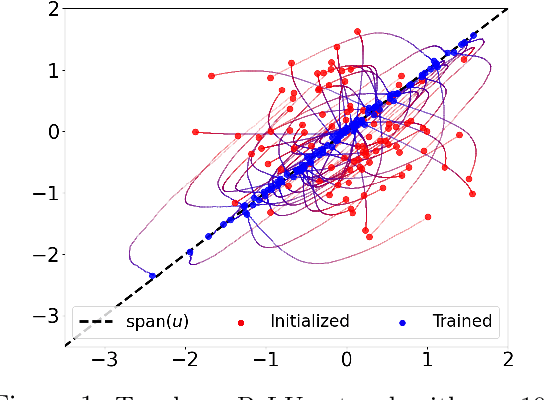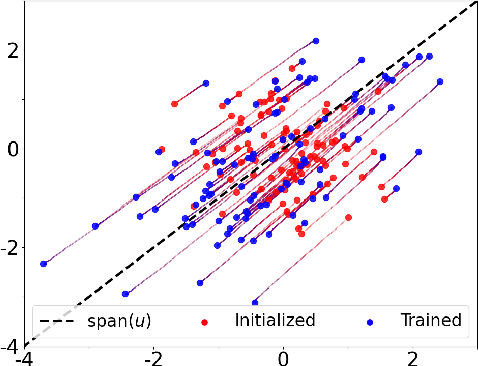Sejun Park
Korea Advanced Institute of Science and Technology
Deep Latent Variable Model based Vertical Federated Learning with Flexible Alignment and Labeling Scenarios
May 16, 2025Abstract:Federated learning (FL) has attracted significant attention for enabling collaborative learning without exposing private data. Among the primary variants of FL, vertical federated learning (VFL) addresses feature-partitioned data held by multiple institutions, each holding complementary information for the same set of users. However, existing VFL methods often impose restrictive assumptions such as a small number of participating parties, fully aligned data, or only using labeled data. In this work, we reinterpret alignment gaps in VFL as missing data problems and propose a unified framework that accommodates both training and inference under arbitrary alignment and labeling scenarios, while supporting diverse missingness mechanisms. In the experiments on 168 configurations spanning four benchmark datasets, six training-time missingness patterns, and seven testing-time missingness patterns, our method outperforms all baselines in 160 cases with an average gap of 9.6 percentage points over the next-best competitors. To the best of our knowledge, this is the first VFL framework to jointly handle arbitrary data alignment, unlabeled data, and multi-party collaboration all at once.
IMPaCT GNN: Imposing invariance with Message Passing in Chronological split Temporal Graphs
Nov 17, 2024Abstract:This paper addresses domain adaptation challenges in graph data resulting from chronological splits. In a transductive graph learning setting, where each node is associated with a timestamp, we focus on the task of Semi-Supervised Node Classification (SSNC), aiming to classify recent nodes using labels of past nodes. Temporal dependencies in node connections create domain shifts, causing significant performance degradation when applying models trained on historical data into recent data. Given the practical relevance of this scenario, addressing domain adaptation in chronological split data is crucial, yet underexplored. We propose Imposing invariance with Message Passing in Chronological split Temporal Graphs (IMPaCT), a method that imposes invariant properties based on realistic assumptions derived from temporal graph structures. Unlike traditional domain adaptation approaches which rely on unverifiable assumptions, IMPaCT explicitly accounts for the characteristics of chronological splits. The IMPaCT is further supported by rigorous mathematical analysis, including a derivation of an upper bound of the generalization error. Experimentally, IMPaCT achieves a 3.8% performance improvement over current SOTA method on the ogbn-mag graph dataset. Additionally, we introduce the Temporal Stochastic Block Model (TSBM), which replicates temporal graphs under varying conditions, demonstrating the applicability of our methods to general spatial GNNs.
A Kernel Perspective on Distillation-based Collaborative Learning
Oct 23, 2024



Abstract:Over the past decade, there is a growing interest in collaborative learning that can enhance AI models of multiple parties. However, it is still challenging to enhance performance them without sharing private data and models from individual parties. One recent promising approach is to develop distillation-based algorithms that exploit unlabeled public data but the results are still unsatisfactory in both theory and practice. To tackle this problem, we rigorously analyze a representative distillation-based algorithm in the view of kernel regression. This work provides the first theoretical results to prove the (nearly) minimax optimality of the nonparametric collaborative learning algorithm that does not directly share local data or models in massively distributed statistically heterogeneous environments. Inspired by our theoretical results, we also propose a practical distillation-based collaborative learning algorithm based on neural network architecture. Our algorithm successfully bridges the gap between our theoretical assumptions and practical settings with neural networks through feature kernel matching. We simulate various regression tasks to verify our theory and demonstrate the practical feasibility of our proposed algorithm.
On Expressive Power of Quantized Neural Networks under Fixed-Point Arithmetic
Aug 30, 2024Abstract:Research into the expressive power of neural networks typically considers real parameters and operations without rounding error. In this work, we study universal approximation property of quantized networks under discrete fixed-point parameters and fixed-point operations that may incur errors due to rounding. We first provide a necessary condition and a sufficient condition on fixed-point arithmetic and activation functions for universal approximation of quantized networks. Then, we show that various popular activation functions satisfy our sufficient condition, e.g., Sigmoid, ReLU, ELU, SoftPlus, SiLU, Mish, and GELU. In other words, networks using those activation functions are capable of universal approximation. We further show that our necessary condition and sufficient condition coincide under a mild condition on activation functions: e.g., for an activation function $\sigma$, there exists a fixed-point number $x$ such that $\sigma(x)=0$. Namely, we find a necessary and sufficient condition for a large class of activation functions. We lastly show that even quantized networks using binary weights in $\{-1,1\}$ can also universally approximate for practical activation functions.
Expressive Power of ReLU and Step Networks under Floating-Point Operations
Jan 26, 2024Abstract:The study of the expressive power of neural networks has investigated the fundamental limits of neural networks. Most existing results assume real-valued inputs and parameters as well as exact operations during the evaluation of neural networks. However, neural networks are typically executed on computers that can only represent a tiny subset of the reals and apply inexact operations. In this work, we analyze the expressive power of neural networks under a more realistic setup: when we use floating-point numbers and operations. Our first set of results assumes floating-point operations where the significand of a float is represented by finite bits but its exponent can take any integer value. Under this setup, we show that neural networks using a binary threshold unit or ReLU can memorize any finite input/output pairs and can approximate any continuous function within a small error. We also show similar results on memorization and universal approximation when floating-point operations use finite bits for both significand and exponent; these results are applicable to many popular floating-point formats such as those defined in the IEEE 754 standard (e.g., 32-bit single-precision format) and bfloat16.
Minimum width for universal approximation using ReLU networks on compact domain
Sep 19, 2023Abstract:The universal approximation property of width-bounded networks has been studied as a dual of the classical universal approximation theorem for depth-bounded ones. There were several attempts to characterize the minimum width $w_{\min}$ enabling the universal approximation property; however, only a few of them found the exact values. In this work, we show that the minimum width for the universal approximation of $L^p$ functions from $[0,1]^{d_x}$ to $\mathbb R^{d_y}$ is exactly $\max\{d_x,d_y,2\}$ if an activation function is ReLU-Like (e.g., ReLU, GELU, Softplus). Compared to the known result $w_{\min}=\max\{d_x+1,d_y\}$ when the domain is ${\mathbb R^{d_x}}$, our result first shows that approximation on a compact domain requires smaller width than on ${\mathbb R^{d_x}}$. We next prove a lower bound on $w_{\min}$ for uniform approximation using general activation functions including ReLU: $w_{\min}\ge d_y+1$ if $d_x<d_y\le2d_x$. Together with our first result, this shows a dichotomy between $L^p$ and uniform approximations for general activation functions and input/output dimensions.
Guiding Energy-based Models via Contrastive Latent Variables
Mar 06, 2023Abstract:An energy-based model (EBM) is a popular generative framework that offers both explicit density and architectural flexibility, but training them is difficult since it is often unstable and time-consuming. In recent years, various training techniques have been developed, e.g., better divergence measures or stabilization in MCMC sampling, but there often exists a large gap between EBMs and other generative frameworks like GANs in terms of generation quality. In this paper, we propose a novel and effective framework for improving EBMs via contrastive representation learning (CRL). To be specific, we consider representations learned by contrastive methods as the true underlying latent variable. This contrastive latent variable could guide EBMs to understand the data structure better, so it can improve and accelerate EBM training significantly. To enable the joint training of EBM and CRL, we also design a new class of latent-variable EBMs for learning the joint density of data and the contrastive latent variable. Our experimental results demonstrate that our scheme achieves lower FID scores, compared to prior-art EBM methods (e.g., additionally using variational autoencoders or diffusion techniques), even with significantly faster and more memory-efficient training. We also show conditional and compositional generation abilities of our latent-variable EBMs as their additional benefits, even without explicit conditional training. The code is available at https://github.com/hankook/CLEL.
On the Correctness of Automatic Differentiation for Neural Networks with Machine-Representable Parameters
Jan 31, 2023Abstract:Recent work has shown that automatic differentiation over the reals is almost always correct in a mathematically precise sense. However, actual programs work with machine-representable numbers (e.g., floating-point numbers), not reals. In this paper, we study the correctness of automatic differentiation when the parameter space of a neural network consists solely of machine-representable numbers. For a neural network with bias parameters, we prove that automatic differentiation is correct at all parameters where the network is differentiable. In contrast, it is incorrect at all parameters where the network is non-differentiable, since it never informs non-differentiability. To better understand this non-differentiable set of parameters, we prove a tight bound on its size, which is linear in the number of non-differentiabilities in activation functions, and provide a simple necessary and sufficient condition for a parameter to be in this set. We further prove that automatic differentiation always computes a Clarke subderivative, even on the non-differentiable set. We also extend these results to neural networks possibly without bias parameters.
Neural Networks Efficiently Learn Low-Dimensional Representations with SGD
Sep 29, 2022

Abstract:We study the problem of training a two-layer neural network (NN) of arbitrary width using stochastic gradient descent (SGD) where the input $\boldsymbol{x}\in \mathbb{R}^d$ is Gaussian and the target $y \in \mathbb{R}$ follows a multiple-index model, i.e., $y=g(\langle\boldsymbol{u_1},\boldsymbol{x}\rangle,...,\langle\boldsymbol{u_k},\boldsymbol{x}\rangle)$ with a noisy link function $g$. We prove that the first-layer weights of the NN converge to the $k$-dimensional principal subspace spanned by the vectors $\boldsymbol{u_1},...,\boldsymbol{u_k}$ of the true model, when online SGD with weight decay is used for training. This phenomenon has several important consequences when $k \ll d$. First, by employing uniform convergence on this smaller subspace, we establish a generalization error bound of $\mathcal{O}(\sqrt{{kd}/{T}})$ after $T$ iterations of SGD, which is independent of the width of the NN. We further demonstrate that, SGD-trained ReLU NNs can learn a single-index target of the form $y=f(\langle\boldsymbol{u},\boldsymbol{x}\rangle) + \epsilon$ by recovering the principal direction, with a sample complexity linear in $d$ (up to log factors), where $f$ is a monotonic function with at most polynomial growth, and $\epsilon$ is the noise. This is in contrast to the known $d^{\Omega(p)}$ sample requirement to learn any degree $p$ polynomial in the kernel regime, and it shows that NNs trained with SGD can outperform the neural tangent kernel at initialization. Finally, we also provide compressibility guarantees for NNs using the approximate low-rank structure produced by SGD.
Generalization Bounds for Stochastic Gradient Descent via Localized $\varepsilon$-Covers
Sep 19, 2022


Abstract:In this paper, we propose a new covering technique localized for the trajectories of SGD. This localization provides an algorithm-specific complexity measured by the covering number, which can have dimension-independent cardinality in contrast to standard uniform covering arguments that result in exponential dimension dependency. Based on this localized construction, we show that if the objective function is a finite perturbation of a piecewise strongly convex and smooth function with $P$ pieces, i.e. non-convex and non-smooth in general, the generalization error can be upper bounded by $O(\sqrt{(\log n\log(nP))/n})$, where $n$ is the number of data samples. In particular, this rate is independent of dimension and does not require early stopping and decaying step size. Finally, we employ these results in various contexts and derive generalization bounds for multi-index linear models, multi-class support vector machines, and $K$-means clustering for both hard and soft label setups, improving the known state-of-the-art rates.
 Add to Chrome
Add to Chrome Add to Firefox
Add to Firefox Add to Edge
Add to Edge